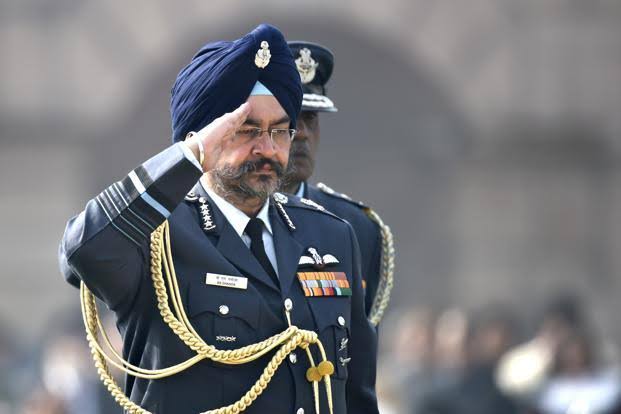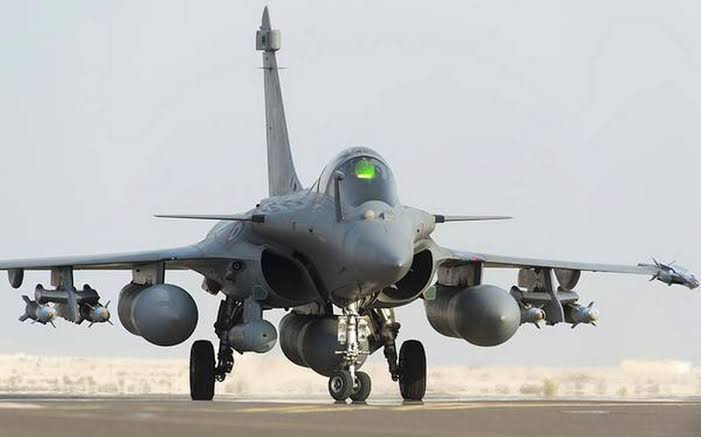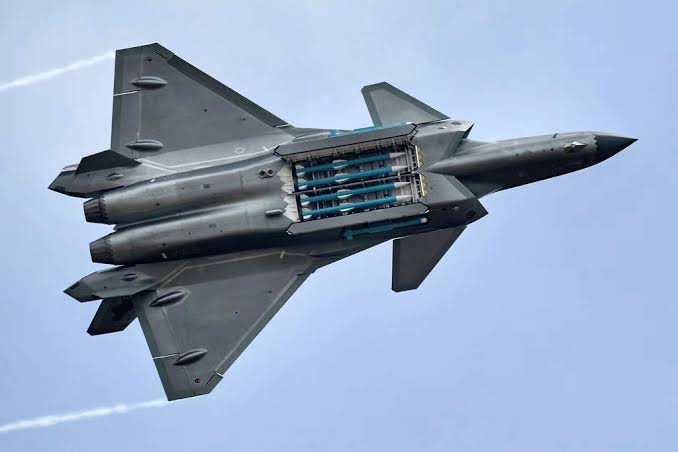Rafale Fighters will not let the Chengdu Dragon….. Fly

By
Colonel Awadhesh Kumar
A big dog fight has erupted on the open internet where both Chinese and Indians are claiming that their newest jets are superior to those of their rival. The virtual fight is between the Chengdu J20 of China and the Rafale Jets which have just begun joining the IAF.
The J-20 or Chengdu fighter is the latest copycat product of China and they have already deployed around 50 of them. Though till recently the Chinese were comparing this so called 5th Generation fighter with F35 of the Yanks, boasting all the stealth qualities, it more or less resembles the F22 of the Americans.

It is indeed bigger than the Rafale and certainly much heavier weighing in at 21 tons. It is a heavy interceptor designed to engage targets at long range rather than a dogfighter. The latest J-20B version as per the Chinese will be equipped with thrust vector control, which permits better maneuverability.
The J-20’s primary weapon is the PL-15, a radar-guided, very-long-range air-to-air missile which may be able to hit aircraft up to 200 kilometres away ( as claimed by China ), outranging weapons like the Meteor U.S. AIM-120 missile.
Indeed by advertising such ranges, PLAAF certainly wants to discourage IAF from trying to engage them over Tibet. Though what to do with all the” Abhinandans” in IAF who do not go by the book and will take on the J20 even with their vintage Bisons, as was done against the F16.

The Rafale in comparison looks very nimbler as it weighs just 10 tons around less than half of J20. Till the arrival of the first of the Rafale Chinese experts had been saying that it is only a third-plus generation fighter jet, and does not stand much of a chance against a stealth, fifth generation one like the J-20.
After the first 5 fighters have joined the IAF, even the Global Times has changed its tune. Now it has itself downgraded the Chengdu J20 to a fourth generation and upgraded the Rafale also to a fourth generation fighter.

Just retired Chairman of Indian Joint Chiefs and erstwhile head of Indian Air Force, ACM B.S. Dhanoa, having combat experience and a test pilot himself, had recently clarified to the Hindustan Times in an interview that China’s new J-20 stealth fighter “doesn’t come close to India’s new French-made Rafale fighters.
Its top-of-the-line electronic warfare suite, Meteor beyond-visual-range [air-to-air] missile and Scalp air-to-ground weapon with its terrain following capability outguns any threat that the Chinese Air Force produces”.
Chinese military experts had earlier been claiming that Rafale was only marginally better other third-plus generation fighter jets used by other countries, but it will find it very difficult to confront a stealth-capable fifth generation fighter jet.
However now The Global Times writes “In some combat performance areas, the Rafale is superior to the Su-30 MKI fighter jets, which are in service in the Indian air force in large batches. It is about one-fourth of a generation more advanced but does not yield a significant qualitative change.”
Though in reality every analyst knows that the AESA radar, advanced weapons and certain stealth technologies, make the Rafael a 4.5-generation fighter. Its moderate stealth capability avoids radar and infrared detection, though less than fifth-generation aircraft like the U.S. F-35.

On the other hand, it is far more superior in a close-range dogfight than even the F-35. The twin-engine Rafale can also use “super cruise” to fly at supersonic speed without gulping fuel as other jets do.
Against Chinese fighters, the Rafale ’s most deadly weapon is the Meteor, a ramjet-powered, radar-guided, beyond visual range (BVR) air-to-air missile with an estimated range of more than 80 kms. Using its AESA radar and Meteor missiles, it will be able to pick off Chinese jets at long range.
The actual game changer for the IAF is not which is better J20 or Rafale. In fact just 5 aircrafts will make no difference just now but 36 of them later on may.
A total of 108 at a later stage will certainly not only make the difference but even turn the tables. So notwithstanding the Babalogs and Saints in the country, IAF must be provided with the additional Rafales.

Remember, the MiG21s in 1965 were the latest in the IAF stable but had to sit out the War. In 1971 they gave a solid drubbing to the PAF. When the first of the deep penetration strike Jaguars landed in India, the Commanding Officer of the Squadron had not been permitted to ferry it from UK.
Wing Commander Nadkarni had flown in the rear seat of one of the trainers. Whereas all five Rafale have been flown nearly 8000kms by our own pilots fully operational on the aircraft on all roles ( less what our TACDE will soon be developing in coming months to surprise even the French ).
For a change, we had a Raksha Mantri, that venerable man Shri Manohar Parrikar who even when about to die kept planning for our defence. He ensured that the notorious MoD and IAF were on the same page with respect to the Rafael’s induction.
This has resulted in a state where the entire connected wherewithal’s from specially designed blast pens to weapon systems, the bombs, the missiles ( less Hammer on order ), the maintenance systems and spares, all are there already in Ambala.
Whereas all these things had followed to Gwalior for Mirage 2000 in 1985, to Pune for Mig29s in 1987 and for the SU30 MKIs in 2000.
In fact our pilots had received virtually no training in Russia on the MiGs and the Sukhois. They attained maturity on these otherwise super aircrafts in India only.
Now coming to these 5 x Rafale. In a all out aerial war over Tibet, these will be just 5 fighters doing their job. However for skirmishes similar to that of 26 Feb and 27 Feb 2019 these 5 will be like the Pandavas of Mahabharat.

As explained by an expert in these matters to me, in a BVR aerial battle MAR or minimum abort range is calculated against the best fighter/ missile combination in play ( on 27 Feb our MAR calculation had catered for the Pakistani AMRAAMS and so the superior missiles became just a diwali rocket for the IAF ).
So over Tibet, the J20 Chengdus can keep calculating the MAR for Rafale / Meteor combination and still get totally surprised. They won’t know what to do when our Astra 2 also joins the fleet.
Another super characteristic of Rafale is its super efficient engine. Even at Lo – Lo -Lo it can travel a great distance with full load, which others cannot do including F35.

This may result in J20s getting surprised over Tibet by the Rafale suddenly appearing among them, as if vectoring in from the direction of Beijing itself. Whereas all the while J20s may keep monitoring the sky towards Ladhak.
Thus IAF is not worried about Chengdus whose weakest link is its engine. The Chinese WS15 engine for powering the J20 have yet to arrive and then prove themselves.
The more potent threat to IAF will be the batteries of China’s surface-to-air missiles deployed in Tibet. How reliable are the Chinese fighters is evident from the fact that even ally Pakistan, which operates Chinese warplanes has little faith in it.
So far the Pakistani Air Force has relied on American-made F-16s and French-made Mirages, while its JF-17 fighters linger in the rear only. Even the Chinese AWACS supplied to Pakistan are seen no where near the Indian border.

In fact Pakistan has mounted a European radar and a Turkish targeting pod on the Chinese JF-17. The J-20 has yet to see action, so its capabilities remains to be seen. Chinese claim that it is stealthy. IAF says that it has been monitoring them whenever they dare to fly over Tibet.
The Rafale on the other hand has seen some combat, but only over poorly defended targets in Afghanistan, Libya, Iraq and Syria. Neither fighter has faced real combat so their strengths and weaknesses still remain a guesstimate.
Pilot quality, ground radar, anti-aircraft missiles, well-integrated command networks, aerial tankers for replenishment, AWAC backup, location of airbases from the battlefield, all these will play a vital role in the outcome of actual battle.
Chinese bases in Tibet have limited means and the altitude reduces the aircrafts load carrying capabilities drastically. Bases in Xinjiang are nearly 900 km away. Where as Indian bases are close by. Even Ambala’s airbase, the home base of the Rafale, is less than 500km from the battle arena.

So while we wait for an aerial version of Galwan, lets just enjoy the media hype on Rafael. After all Pakis had also gone out of their way to celebrate the arrival of F16.




